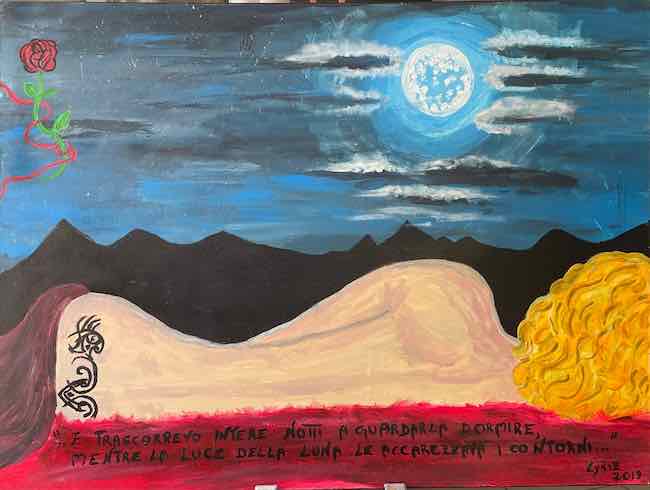La sperimentazione appartiene inevitabilmente a quel mondo artistico attuale in cui sembra quasi essere troppo limitante soffermarsi su uno stile specifico, perché la conoscenza del recente passato, quello del secolo scorso, le rivoluzioni che si sono verificate grazie al desiderio di rompere gli schemi che aveva contraddistinto gli artisti protagonisti di quel particolare periodo, hanno aperto le porte alla possibilità per i contemporanei, di generare una sintesi ampliando e mescolando i linguaggi precedenti. Senza più la necessità di identificarsi e riconoscersi all’interno di un gruppo o un movimento specifico, i creativi del ventunesimo sono liberi di poter dar vita allo stile più affine alla propria indole e al proprio intento espressivo. La protagonista di oggi sceglie due linguaggi apparentemente opposti dal punto di vista formale eppure in grado di fondersi per narrare la realtà secondo il suo punto di vista, sottolineando i particolari che desidera mettere in evidenza.
Quando l’esigenza di manifestare il proprio sentire interiore, di lasciar fuoriuscire quelle emozioni che tanto erano state messe in secondo piano rispetto alla perfezione estetica, alla rigorosità del rispetto delle regole accademiche e alla contemplazione formale dell’opera, cominciò a essere irrinunciabile, nacque in Europa un movimento destinato a cambiare le regole e persino la struttura pittorica, permettendo agli artisti di ripudiare tutte quelle limitazioni che potessero impedire loro di liberare ciò che era sempre stato tenuto in disparte. L’Espressionismo divenne interpretazione delle ansie, delle angosce ma anche dei momenti di evasione, di familiarità, di dialogo con l’interiorità o con il sogno, malgrado la rinuncia alla struttura tradizionale dell’opera d’arte, o forse proprio grazie a questa scelta. I più vicini agli inizi Fauves come Henri Matisse, André Derain e Maurice de Vlaminck mostravano una gamma cromatica intensa, completamente irreale poiché necessariamente affine al vorticoso sentire interiore anche dei momenti di svago; altri più tendenti verso un approccio più tempestoso volto a sottolineare la cupezza dei tempi di quell’epoca in bilico tra ipocrisia borghese e venti di guerra, come Edvard Munch e Oskar Kokoshka, erano contraddistinti da colori scuri e atmosfere a volte angoscianti e infine quelli più orientati a vivere la pittura come una fuga dalla realtà oggettiva, come il sognatore Marc Chagall e il viaggiatore Paul Gauguin in cui le linee divennero meno nette, il colore era più morbido e al tempo stesso vivace, espressione perfetta del loro mondo creativo. Dall’Espressionismo in avanti la storia dell’arte cominciò a correre verso una serie di stravolgimenti, di trasformazioni talmente radicali da allontanarsi in maniera sempre più incisiva dalla figurazione e tendere verso la non forma per poi compiere una brusca retromarcia nella seconda metà del Novecento, quando dopo una fase di completa concettualità emerse l’esigenza di ricominciare a comunicare con un pubblico ampio attraverso un linguaggio semplice e immediato, dunque figurativo anche se stilizzato, come nel caso della Street Art in cui i writers volevano esprimere le loro sensazioni, a volte addirittura rabbiose, con la velocità necessaria per evitare di essere scoperti, utilizzando perciò bombolette spray e stencil. L’artista bolzanina Laura Innocenti, in arte Lyriz, rivisita in modo del tutto personale non solo l’Espressionismo che è alla base del suo linguaggio pittorico nonché manifestazione del suo approccio all’esistenza, ma anche l’utilizzo di tecniche appartenenti alla Street Art che nel suo caso entrano in dialogo con i personaggi, umani o animali, che sceglie di rendere protagonisti delle sue tele.
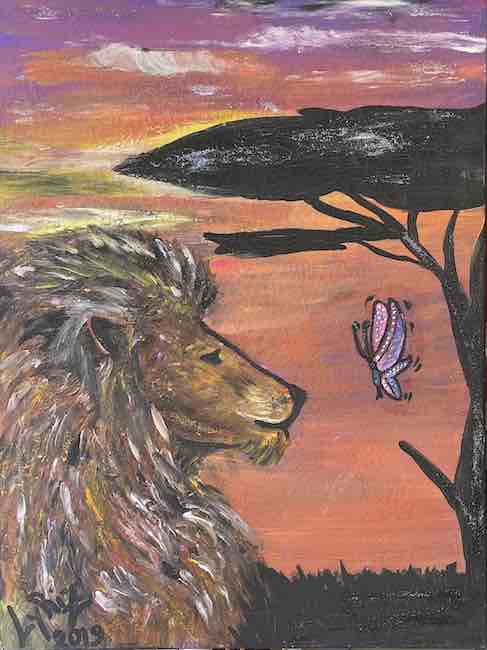
Laddove la gamma cromatica è irreale, affine all’emozione percepita dall’artista e reinterpretata nel momento dell’approccio alla tela, di contro l’utilizzo di bombolette spray e di glitter diviene quasi un modo per far sentire la sua voce pittorica più incisivamente, tanto quanto forte dovevano gridare gli esecutori di graffiti per farsi ascoltare da una società contro cui spesso dovevano combattere.
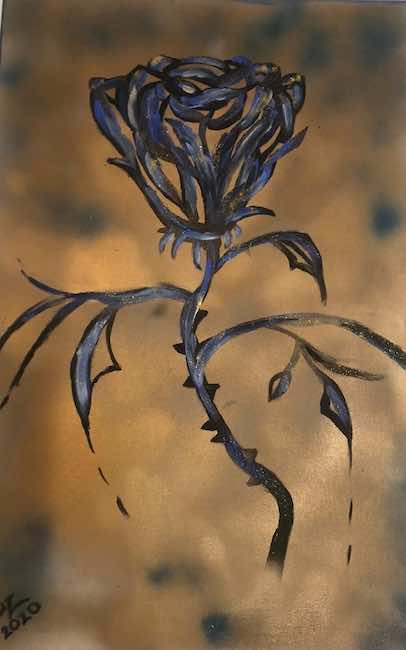
Nel caso di Lyriz l’esigenza non è quella di gridare la rabbia piuttosto quella di trovare una modalità personale per esprimere il proprio sentire, le emozioni che dai suoi soggetti traspaiono evidenziando sempre un grande amore per la natura e per gli animali; la necessità di misurarsi con materiali usati nel Graffitismo, pur non adottandone lo stile espressivo, la rende estremamente contemporanea, metropolitana, esplorativa nei confronti di un mondo, quello dell’arte attuale, che si pone come superamento dei movimenti del secolo scorso e come sintesi di quei linguaggi singoli in grado di dare vita a qualcosa di dinamicamente nuovo. La contemplazione e la riflessione sembrano essere le linee guida della sua personalità pittorica, quella capacità di osservare ciò che la circonda o su cui il suo sguardo si è posato in occasione di un viaggio o ancora interpretando un pensiero che ha toccato la sua sensibilità, e poi di lasciarlo affondare nelle corde interiori, rielaborandolo prima di essere in grado di lasciarlo rivivere sulla tela.
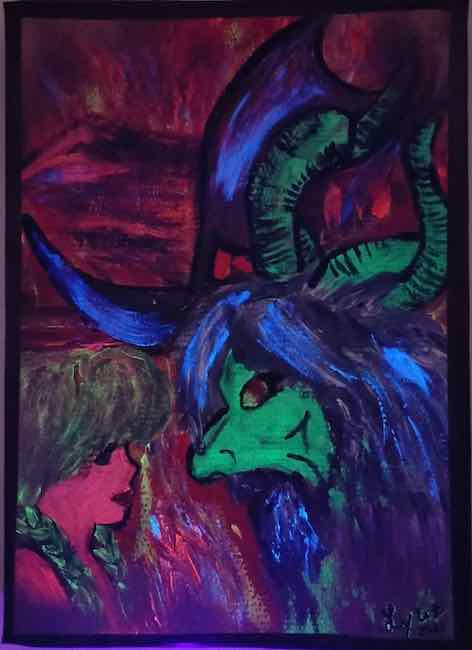
Non solo, Lyriz si mette in ascolto delle energie circostanti, di quella spiritualità che avvolge il visibile e che non può essere colto dallo sguardo, e le rende coprotagoniste delle sue atmosfere in cui alcuni elementi sono addirittura metafore dei concetti che desidera raccontare, con una semplicità espressiva che permette al suo messaggio di essere chiaro.
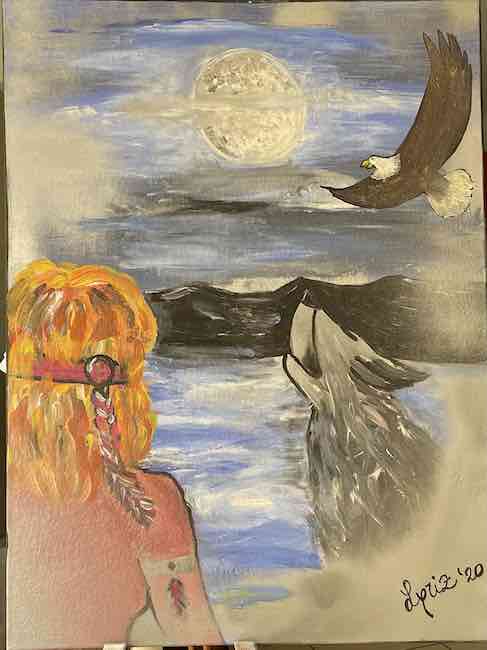
Nella tela Spiriti guida mette in risalto tutti quei simboli che da sempre contraddistinguono la libertà, la forza, l’approfondimento e la riflessione e che si propongono alla protagonista, rappresentata di spalle all’osservatore, quasi in maniera casuale, come se volessero solo sussurrare la loro presenza pur essendo lì per un motivo specifico. È questo l’invito dell’artista, di ascoltare quelle energie che ruotano intorno all’essere umano nella quotidianità e che spesso vengono ignorate, quei segnali fortemente presenti e pronti a indicare la via ma visibili solo a pochi sensibili in grado di comprendere quel linguaggio simbolico. Il lupo, l’aquila, la luna, sono elementi preziosi in molte civiltà pagane in cui però il rapporto con le energie della natura era più forte di qualsiasi tipo di religione.
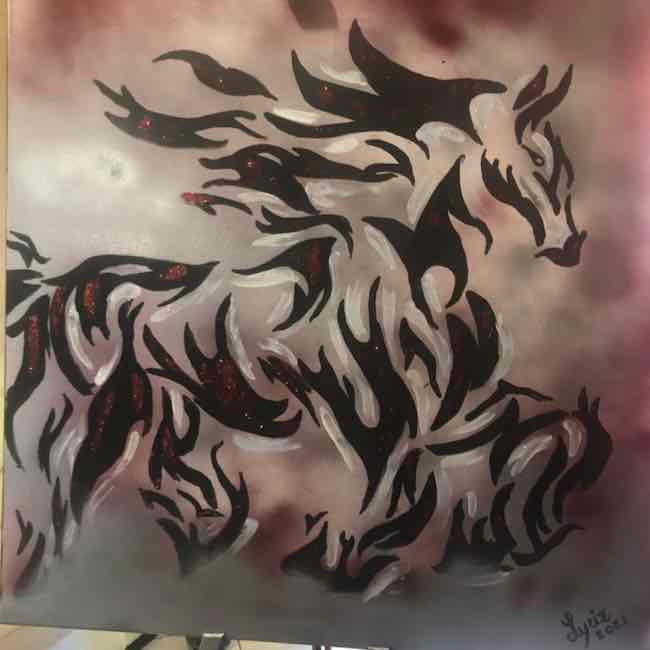
In Free spirit (Spirito libero) Lyriz parla di libertà ancora una volta attraverso un animale, il cavallo selvaggio che non può e non deve essere imbrigliato e di cui tratteggia solo i contorni quasi a sottolineare quanto sia impossibile fermare la sua corsa o costringerlo all’interno di uno schema a cui non si assoggetterà mai. In qualche modo attraverso quest’opera, realizzata in acrilico, glitter e bomboletta spray, amplifica la metafora nei confronti di una certa tipologia di persone, quelle che non si piegano alle avversità, che non si lasciano gestire, che cercano sempre un modo per riuscire a mantenere la propria autonomia, a perseguire i propri desideri, a inseguire i propri sogni. Le opere di Lyriz raccontano di sentimenti puri, di emozioni semplici perché in fondo è questo che rende l’esistenza più bella, più piacevole e in fondo più vera; ed è questo che conquista l’osservatore, il suo linguaggio diretto e al tempo stesso quasi magico perché si spinge all’interno della spiritualità, la evidenzia, la porta alla luce.
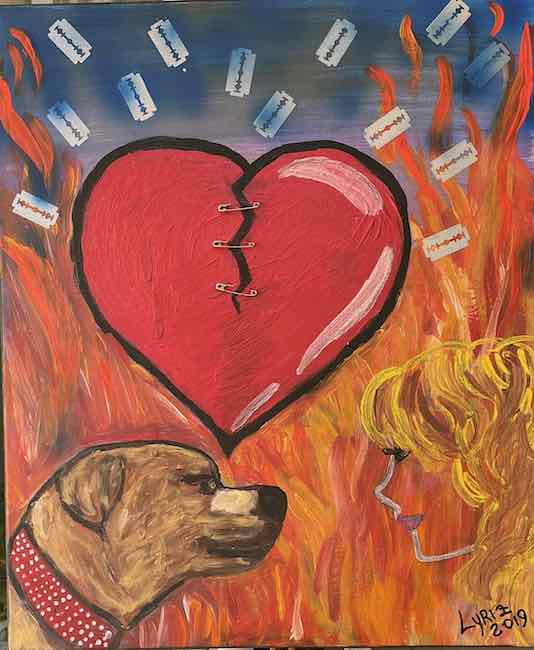
Nell’opera Daphne vira ancor più verso la Street Art inserendo elementi che evocano in qualche modo, pur private della stilizzazione, le atmosfere serene e spontanee di Keith Haring, ma aggiungendo elementi materici moderni e metropolitani come le lamette che hanno tagliato il cuore poi rattoppato con le spille da balia, per raccontare quanto quell’amore per un animale, il cane, abbia le stesse caratteristiche di profondità e intensità di quello che si sprigiona durante un colpo di fulmine. In quest’opera il tratto è persino più semplificato, la gamma cromatica è in armonia con l’emozione che permea l’intera tela e dunque ruota intorno alle tonalità del rosso, dell’arancio, simboli di vitalità e di vivacità.
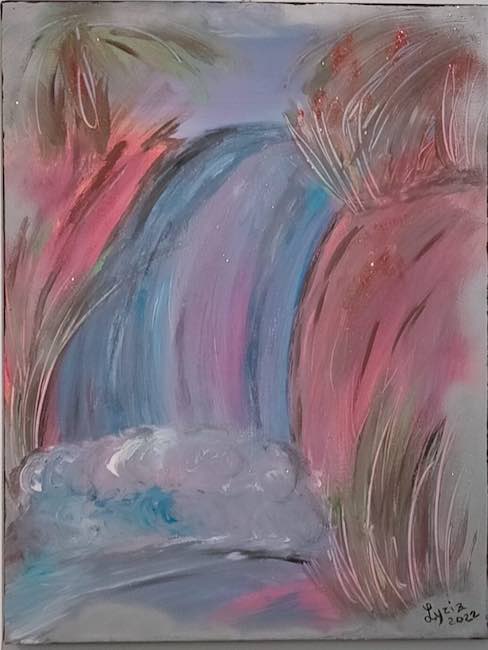
Il dipinto Cascata invece racconta dell’importanza dell’acqua intesa come flusso dell’esistenza, come sinonimo di cambiamento, come capacità di adattarsi alle situazioni viste come stimolo all’evoluzione, ma soprattutto l’acqua rappresenta la capacità di rigenerarsi, di purificarsi trovando costantemente nuova linfa vitale. Lyriz ha alle spalle un lungo percorso artistico – e non solo in campo pittorico bensì anche come autrice di racconti e di poesie -, che l’ha vista partecipare a molte mostre collettive in Alto Adige e a Bolzano con il Club Arcimboldo di cui è socia; nel 2021 riceve il Primo Premio al concorso Bici in Fiore con l’opera La rosa neroazzurra che piange per Berghem.
LAURA INNOCENTI-CONTATTI
Email: laurapeace74@hotmail.it
Facebook: https://www.facebook.com/laura.innocenti.965
Instagram: https://www.instagram.com/lyriz_cappuccettorossosangue/
Expressionism meets Street Art techniques in Lyriz’s strong-toned artworks
Experimentation inevitably belongs to that current artistic world in which it seems almost too limiting to dwell on a specific style, because the knowledge of the recent past, that of the last century, the revolutions that took place thanks to the desire to break the mould that had characterised the leading artists of that particular period, have opened the door to the possibility for contemporaries to generate a synthesis by expanding and mixing previous languages. No longer needing to identify and recognise themselves within a specific group or movement, the creatives of the 21st century are free to give life to the style most akin to their own nature and expressive intent. Today’s protagonist chooses two apparently opposing languages from a formal point of view, yet they are able to merge in order to narrate reality according to her point of view, emphasising the details she wishes to highlight.
When the need to manifest one’s inner feelings, to let out those emotions that had been so much put on the back burner compared to aesthetic perfection, the strictness of adherence to academic rules and the formal contemplation of the artwork, began to be indispensable, a movement was born in Europe that was destined to change the rules and even the structure of painting, allowing artists to repudiate all those limitations that could prevent them from releasing what had always been kept on the sidelines. Expressionism became an interpretation of anxieties, anguish but also moments of escapism, of familiarity, of dialogue with the inner self or with the dream, despite the renunciation of the traditional structure of the artwork, or perhaps because of this very choice. Those closer to the early Fauves such as Henri Matisse, André Derain and Maurice de Vlaminck displayed an intense, completely unreal colour palette that was necessarily akin to the swirling inner feeling of even moments of leisure; others tended towards a more stormy approach aimed at emphasising the gloominess of the times poised between bourgeois hypocrisy and the winds of war, such as Edvard Munch and Oskar Kokoshka, were characterised by dark colours and sometimes distressing atmospheres, and finally those more oriented towards experiencing painting as an escape from objective reality, such as the dreamer Marc Chagall and the traveller Paul Gauguin in whom the lines became less sharp, the colour was softer and at the same time more vivid, a perfect expression of their creative world. From Expressionism onwards, the history of art began to run into a series of upheavals, of transformations so radical that it moved increasingly away from figuration and tended towards non-form, only to reverse abruptly in the second half of the 20th century, when, after a phase of complete conceptuality, emerged the need to start communicating with a broad public again through a simple and immediate language, thus figurative even if stylised, as in the case of Street Art in which writers wanted to express their feelings, sometimes even angry, with the necessary speed to avoid being discovered, therefore using spray cans and stencils. The Bolzano artist Laura Innocenti, aka Lyriz, revisits in a very personal way not only Expressionism, which is the basis of her pictorial language as well as a manifestation of her approach to existence, but also the use of techniques belonging to Street Art, which in her case enter into dialogue with the characters, human or animal, that she chooses to make the protagonists of her canvases.
Where the chromatic range is unreal, akin to the emotion perceived by the artist and reinterpreted when approaching the canvas, on the other hand, the use of spray cans and glitter becomes almost a way of making her pictorial voice heard more incisively, just as loudly as the graffiti artists had to shout in order to be heard by a society they often had to fight against. In Lyriz’s case, the need is not to shout out anger, but rather to find a personal way of expressing her feelings, the emotions that transpire from her subjects, always highlighting a great love for nature and animals. The need to measure herself with materials used in Graffitism, while not adopting its expressive style, makes her extremely contemporary, metropolitan, exploratory in relation to a world, that of present-day art, which stands as an overcoming of the movements of the last century and as a synthesis of those individual languages capable of giving life to something dynamically new. Contemplation and reflection seem to be the guiding lines of her pictorial personality, that ability to observe what surrounds her or on which her gaze has rested on the occasion of a journey or while interpreting a thought that has touched her sensitivity, and then to let it sink into her inner chords, reworking it before being able to let it live again on canvas. Not only that, Lyriz listens to the surrounding energies, to that spirituality that envelops the visible and cannot be grasped by the eye, and she makes them co-protagonists of her atmospheres in which some elements are even metaphors for the concepts she wishes to recount, with an expressive simplicity that allows her message to be clear. In the canvas, Guiding Spirits emphasises all those symbols that have always characterised freedom, strength, deepening and reflection, and which present themselves to the protagonist, depicted with her back to the observer, almost casually, as if they only want to whisper their presence even though they are there for a specific reason. This is the artist’s invitation, to listen to those energies that revolve around the human being in everyday life and that are often ignored, those signals that are strongly present and ready to show the way but visible only to a sensitive few capable of understanding that symbolic language.
The wolf, the eagle, the moon, are precious elements in many pagan civilisations in which, however, the relationship with the energies of nature was stronger than any kind of religion. In Free spirit, Lyriz speaks of freedom once again through an animal, the wild horse that cannot and must not be harnessed and of which she only sketches the outlines almost as if to emphasise how impossible it is to stop its race or to force it within a scheme to which it will never submit. Somehow through this painting, made of acrylic, glitter and spray cans, she amplifies the metaphor towards a certain type of people, those who do not bend to adversity, who do not allow themselves to be managed, who are always looking for a way to be able to maintain their autonomy, to pursue their desires, to pursue their dreams. Lyriz’s works tell of pure feelings, of simple emotions because in the end this is what makes existence more beautiful, more pleasant and in the end more real; and it is this that conquers the observer, her direct and at the same time almost magical language because it pushes inside spirituality, highlights it, brings it to light. In the painting Daphne veers even more towards Street Art, inserting elements that somehow evoke, albeit deprived of stylisation, the serene and spontaneous atmospheres of Keith Haring, but adding modern and metropolitan material elements such as the razor blades that cut the heart then patched up with safety pins, to tell how much that love for an animal, the dog, has the same depth and intensity as that which is released during a love at first sight. In this artwork the stroke is even more simplified, the chromatic range is in harmony with the emotion that permeates the entire canvas and therefore revolves around shades of red and orange, symbols of vitality and liveliness. The painting Waterfall, on the other hand, tells of the importance of water intended as the flow of existence, as a synonym for change, as the ability to adapt to situations seen as a stimulus for evolution, but above all water represents the ability to regenerate, to purify oneself by constantly finding new lifeblood. Lyriz has a long artistic career behind her – not only as a painter but also as an author of short stories and poems -, which has seen her taking part in many group exhibitions in South Tyrol and Bolzano with the Club Arcimboldo, of which she is a member; in 2021 she was awarded First Prize in the Bici in Fiore competition with her work The black and blue rose crying for Berghem.


